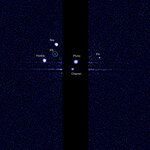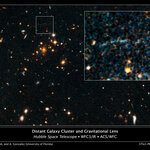Space

We
live in times of extraordinary discovery. Exoplanets appear to be quite common
in our galaxy. NASA’s Kepler Telescope has identified over 2,000 planetary
candidates orbiting other stars. And yet the universe appears to be silent – at
least when it comes to any detectable signs of alien civilizations, either at
present in our galaxy or their remnants from the last couple of billion
years.
And
let’s be clear: it isn’t just the failure of SETI (the Search for ExtraTerrestrial Intelligence) to detect
radio signals that constitutes “silence.” Indeed, there are strong reasons…

A newly discovered exoplanet is two-thirds the size of Earth and a relatively close 33 light years away.
But is it really a planet? UCF 1.01 is being called an exoplanet candidate. The reason is because a measured mass is needed to verify that it is a planet, but even the most sensitive instruments currently available are unable to measure exoplanet masses this small.UCF 1.01 is so close to its star it orbits in 1.4 days. The planet's surface likely reaches temperatures of more than 1,000 degrees Fahrenheit and it probably has no atmosphere. Its surface may be volcanic or molten.
The…

For not being a planet, according to 2 percent of astronomers, Pluto sure has a lot of moons.
Now it has one more, joining Charon, which was discovered in 1978, Nix and Hydra, discovered in 2006, and P4, found in 2011.
Pluto’s new-found moon, provisionally designated S/2012 (134340) 1, or P5, is tiny and only visible as a speck of light in Hubble images, so it is estimated to be irregular in shape and between 10 and 25 kilometers across. It is in a 95,000 kilometer-diameter circular orbit and assumed to lie in the same plane as Pluto’s other known moons.
Really, though, the name P5 is…

Dark galaxies, theorized but unobserved, may have been spotted.
Dark galaxies are essentially gas-rich galaxies in the early Universe that are very inefficient at forming stars and astronomers think they have detected these elusive objects by observing them glowing as they are illuminated by a quasar. They are predicted by theories of galaxy formation and are thought to be the building blocks of today’s bright, star-filled galaxies. They may have fed large galaxies with much of the gas that later formed into the stars that exist today.
Because they are essentially devoid of stars, dark…

Why do some extremely faint galaxies in our backyard contain so few stars? An international team of astronomers has helped solve the mystery of why these galaxies are starved of stars - and why so few of them have been found.
Hercules, Leo IV and Ursa Major dwarf galaxies all started forming stars more than 13 billion years ago - and then abruptly stopped shortly after the Big Bang.The extreme age of their stars is similar to Messier 92, the oldest known globular cluster in the Milky Way.
The relics are evidence for a transitional phase in the early Universe that shut down star-making…

V1647 Ori resides 1300 light-years away in McNeil’s Nebula. It is a young Sun-like star spinning at high speed and spewing out super-hot plasma and astronomers have now been able to deduce what might be happening behind the dusty disc cloaking the star. Three telescopes, XMM-Newton, Chandra, and Suzaku, have kept their eyes on it during two multi-year outbursts. The first lasted from 2003 to 2006; the second has been under way since 2008. During these extended outbursts the star displays faster growth in mass, a surge in X-ray emission and a dramatic increase in temperature to 50…

The atmosphere of exoplanet HD 189733b, about 60 light-years from Earth, changed dramtically after a violent flare on its parent star bathed it in intense X-ray radiation. Result: A powerful burst of evaporation.
The Hubble Space Telescope caught the whole thing during two periods in early 2010 and late 2011 as it was silhouetted against its parent star - known as the the transit method of observation (see Planet Hunters - How They Do It for various ways planet discoveries and observations are made). While backlit in this way, HD 189733b’s atmosphere 'imprinted' its chemical signature…

Astronomers have found a puzzling arc of light behind an extremely massive cluster of galaxies residing 10 billion light-years away. The galactic grouping was observed when the universe was roughly a quarter of its current age of 13.7 billion years and the giant arc is the stretched shape of a more distant galaxy whose light is distorted by the monster cluster's powerful gravity, the effect called gravitational lensing.
The puzzle is, the arc shouldn't exist.
Galaxy clusters are collections of hundreds to thousands of galaxies bound together by gravity. They are the most massive structures in…

Well, so as predicted Venus passed over the disk of our Sun yesterday (this morning, if you live in Europe), and it produced quite a show, as many pictures and videos available around testify. To make the view more pleasing, our Sun was showing a discrete amount of solar spots, betraying the fact that we are approaching Solar Max (there is a 11-year cycle of solar activity, which manifests itself visually with black spots appearing on the disk, and on the Earth with auroras and electromagnetic disturbances).
In case you want a quick link to a nice slideshow showing Venus crossing the Sun's…
This afternoon I will attempt to stream the transit of Venus live on an embedded stream on this website.
Meanwhile here are some resources on observing the transit.
First a personal opinion, don't bother with using a so called "pinhole projector". The image of the sun projected is a point of light, you are then looking for a tiny tiny point of dark on a tiny point of light.
The technique I will use is to use a telescope with the eyepieces removed to project an image which a webcam can then focus on. NEVER LOOK DIRECTLY AT THE SUN ESPECIALLY THROUGH A TELESCOPE…